Apps
Auto Added by WPeMatico
Auto Added by WPeMatico
Bumble, currently Tinder’s biggest rival in the dating app market, today launched its own version of Tinder’s “Boost” feature. On Bumble, it’s being called “Spotlight,” and allows users to pay to bump their profile to the front of the queue in order to be seen by more people than they would otherwise.
Very much like Tinder Boost, the idea here is that getting to the front of the line will allow you to pick up matches more quickly, as you don’t have to wait until users swipe through other profiles before they see yours. Plus, depending on how far in the back of the line you are typically, Spotlight could help you be seen by those who would have never made it to your profile page at all.
Spotlight — or Boost, for that matter — isn’t something every dating app user needs.
Dating apps today organize their queues with profiles based on a number of factors — including things like profile popularity, whether you swipe right on everyone or are more selective, whether your photos are higher quality or blurry and many other signals. If you tend to get matches easily on the apps, you may not need Spotlight. But if you suspect your profile is farther down the line, or just want to make sure your profile is getting seen, the feature could help.

To use Spotlight, Bumble users must pay two Coins (bought through a separate in-app purchase). One coin is $0.99 in the U.S., or £1.99 in the U.K. Spotlight will then show your profile to more users for the next 30 minutes. Your profile is not flagged or labeled in any way, so no one knows you used Spotlight to be promoted. However, the user who purchased Spotlight will know it’s active as they’ll see stars appear across the top part of the Bumble app while it’s enabled.
Spotlight represents another way that Bumble continues to challenges Tinder head-on by rolling out similar features, after already co-opting the swipe-to-like and the super-like, for example.
The move also comes following another successful quarter by Match Group, led by the earnings from its flagship app, Tinder.

Combined with its other dating app properties, Match pulled in $457 million in revenue, up 21 percent year-over-year, and topping analyst estimates. Tinder reported its paying subscriber base grew to 4.3 million as of year-end, out of a total user base that tops 50 million. (The company doesn’t disclose the number of users it has.)
Bumble, meanwhile, today says it has now reached 50 million worldwide users, with 84,000 new users being added daily.
Spotlight is one of several in-app purchases offered by Bumble, alongside the recently launched option to access more profile filters, for example, as well as free features, like Snooze, which lets you take a digital detox from online dating.
Update, 2/11/19, 6 PM ET:
Shortly after Bumble announced the launch of its new feature, Hey Vina – an app for women who want to make friends – announced that Bumble had stolen the concept and name from them. Notably, Tinder has an investment in Vina.
“Vina launched the ‘Spotlight’ feature version of Tinder Boost a month ago,” wrote Hey Vina CEO Olivia June, in an email to TechCrunch. “I just wanted to point this out given that the feature is so similar to ours, that they named it the same as ours, and that Vina (being Tinder’s move in the friendship space) launched before Bumble BFF.”
Bumble and Tinder have been at odds for some time, following Match’s inability to acquire Bumble. The two are involved in lawsuits, and now regularly rip each other off.
Powered by WPeMatico
Facebook co-founder Sean Parker bankrolled Brigade to get out the vote and stimulate civic debate, but after five years and little progress the startup is splitting up, multiple sources confirm to TechCrunch. We’ve learned that Pinterest has acqhired roughly 20 members of the Brigade engineering team. The rest of Brigade is looking for a potential buyer or partner in the political space to take on the rest of the team plus its tech and product. Pinterest as well as Brigade CEO Matt Mahan confirmed the fate of the startup to TechCrunch.
While Brigade only formally raised $9.3 million in one round back in 2014, the company had quietly expanded that Series A round with more funding. A former employee said it had burned tens of millions of additional dollars over the years. Brigade had also acquired Causes, Sean Parker’s previous community action and charity organization tool. For now, Brigade’s product will continue running managed by a skeleton crew until a partner or buyer can be found.
After Brigade launched as an app for debating positions on heated political issues but failed to gain traction, it pivoted into what Causes had tried to be — a place for showing support for social movements. More recently, it’s focused on a Rep Tracker for following the stances and votes of elected officials. Yet the 2016 campaign and 2018 midterms seem to fly over Brigade’s head. It never managed to become a hub of activism, significantly impact voter turnout, or really even be part of the conversation.

After several election cycles, I hear the Brigade team felt like there had to be better ways to influence democracy or at least create a sustainable business. One former employee quipped that Brigade could have made a greater impact by just funneling its funding into voter turnout billboards instead of expensive San Francisco office space and talent.
The company’s mission to spark civic engagement was inadvertently accomplished by Donald Trump’s election polarizing the country and making many on both sides suddenly get involved. It did succeed in predicting Trump’s victory, after its polls of users found many democrats planned to vote against their party. But while Facebook and Twitter weren’t necessarily the most organized or rational places for discourse, it started to seem unnecessary to try to build a new hub for it from scratch.
Brigade accepted that its best bet was to refocus on govtech infrastructure like its voter identification and elected official accountability tools, rather than a being a consumer destination. Its expensive, high-class engineering team was too big to fit into a potential political technology acquirer or partner. Many of those staffers had joined to build consumer-facing products, not govtech scaffolding.
Mahan, Brigade’s co-founder and CEO as well as the former Causes CEO, confirms the breakup and Pinterest deal, telling us “We ended up organizing the acqhire with Pinterest first because we wanted to make sure we took care of as many people on the team as possible. We were incredibly happy to find that through the process, 19 members of our engineering team earned offers and ended up going over to Pinterest. That’s about two-thirds of our engineering team. They were really excited about staying in consumer product and saw career opportunities at Pinterest.” A Pinterest spokesperson told us “We’re excited to welcome Brigade engineers to Pinterest, including former Brigade CTO John Thrall and VP of Engineering Trish Gray. As experts across areas like Growth and Product Engineering, they’ve spent years building products that inspire people to go out into the real world and take action.”
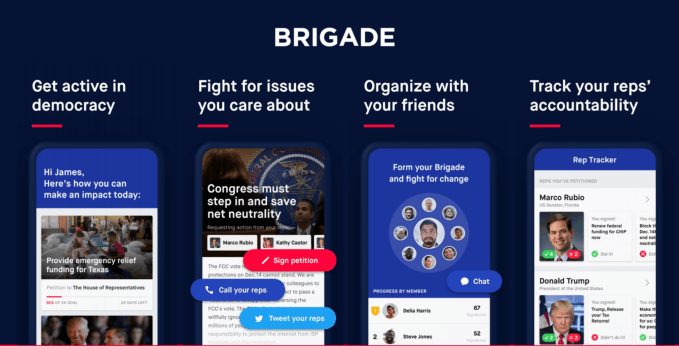
Brigade had interest from multiple potential acqhirers and allowed the engineering team’s leadership to decide to go with Pinterest. Several of Brigade’s engineers and its former VP of Engineering Trish Gray already list on LinkedIn that they’ve moved to Pinterest in the past few months. “We had a bunch of employees that took a risk on a very ambitious plan to improve our democracy and we didn’t want to leave them out to dry” Mahan stresses. “We spent more time and more money and more effort in taking care of employees over the last few months than most companies do and I think that’s a testament to Sean and his values.”
Mahan is currently in talks with several potential hosts for the next phase of Brigade, and hopes to have a transition plan in place in the next month. “We’ve in parallel been exploring where we take the technology and the user base next. We want to be sure that it lives on and can further the mission the we set out to achieve even if it doesn’t look like the way it does today.” Though the company’s output is tough to measure, Mahan tells me that “Brigade built a lot of foundational technology such as high quality voter matching algorithms and an entire model for districting people to their elected representatives. My hope for our legacy is that we were able to solve some of these problems that other people can build on.” Given Parker’s previous work with Marijuana legalization campaign Prop 64 in California and his new Opportunity Zones tax break effort, Brigade’s end won’t be Parker’s exit from politics.
Brigade’s breakup could still cast an ominous shadow over the govtech ecosystem, though. Alongside recent layoffs at grassroots campaign text message tool Hustle, it’s proven difficult for some startups in politics to become sustainable businesses. Exceptions like Palantir succeed by arming governments with data science that can be weaponized against citizens. Yet with the 2020 elections around the corner, fake news and election propaganda still a threat, and technology being applied for new nefarious political purposes, society could benefit from more tools built to amplify social justice and a fair democratic process.
Powered by WPeMatico
Ticketing app Gametime is taking its last-minute approach about as far as it can go, with the launch of a new feature called LastCall. This allows users to purchase tickets through Gametime until 90 minutes after an event has started.
Why would you want to do that? Well, prices usually drop precipitously after the event starts — for example, Gametime said that 48 hours before a game, the median price for a Major League Baseball is (coincidentally?) $48, but it’s dropped to $13 by 90 minutes after the first pitch.
Founder and CEO Brad Griffith acknowledged that most fans probably aren’t interested in just showing up for the fourth quarter or ninth inning of a game, or for the last song in a concert. On the other hand, if you could get a big discount and still catch most of the event, then it might be worth it.
Meanwhile, if you’re a team or a venue with empty seats, or if you’re a ticket-holder who realizes at the last minute that you can’t attend, then it’s good to have one last shot at selling those tickets.
In fact, it sounds like this is one of those “announcements” that’s partly acknowledging what’s already happening, both in the Gametime app and elsewhere. Griffith said the company is “doubling down” on this last-last-minute category of tickets, adding that it’s “constantly working through” what it’s actually including under the LastCall umbrella.
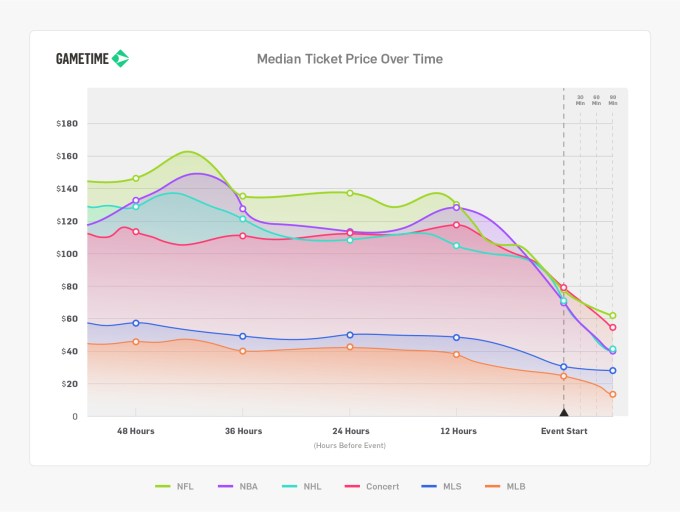
“The key element is the research that we’ve done, how it relates to the growth of this phenomenon” he said.
That research includes a survey of 287 event attendees, some who use Gametime and some who don’t. Apparently 27 percent said they’ve already purchased tickets after an event’s start time, and 62 percent of those late buyers were either Generation Z or millennials.
And while Gametime started out with a focus on sports, LastCall will include tickets from a variety of live events. In fact, Griffith said concerts are now the app’s fastest-growing category, and he suggested that this approach could help with the declining number of total concert tickets sold.
“We’re starting to see a bifurcation of windows, where the on-sale is still healthy, is strong, and the middle is maybe cratering in terms of transaction volume,” he said. “And then last-minute is vibrant and growing fast. That is where we aim to do our best work.”
Powered by WPeMatico
If you can’t beat or join them… force feed ’em? That appears to be Instagram’s latest strategy for IGTV, which is now being shoved right into Instagram’s main feed, the company announced today. Instagram says that it will now add one-minute IGTV previews to the feed, making it “even easier” to discover and watch content from IGTV.
Uh.
IGTV, you may recall, was launched last year as a way for Instagram to woo creators. With IGTV, creators are able to share long-form videos within the Instagram platform instead of just short-form content to the Feed or Stories.
The videos, before today, could be viewed in Instagram itself by tapping the IGTV icon at the top-right of the screen, or within the separate IGTV standalone app.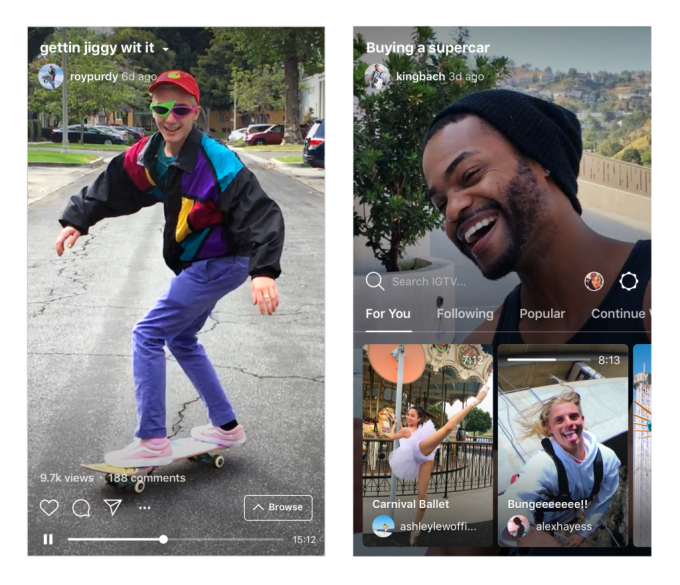 Instagram’s hope was that IGTV would give the company a means of better competing with larger video sites, like Google’s YouTube or Amazon’s Twitch.
Instagram’s hope was that IGTV would give the company a means of better competing with larger video sites, like Google’s YouTube or Amazon’s Twitch.
Its users, however, haven’t found IGTV as compelling.
As of last fall, few creators were working on content exclusively for IGTV, and rumor was the viewing audience for IGTV content remained quite small, compared with rivals like Snapchat or Facebook. Many creators just weren’t finding it worth investing additional resources into IGTV, so were repurposing content designed for other platforms, like YouTube or Snapchat.
That means the bigger creators weren’t developing premium content or exclusives for IGTV, but were instead experimenting by replaying the content their fans could find elsewhere. Many are still not even sure what the IGTV audience wants to watch.
IGTV’s standalone app doesn’t seem to have gained much of a following either.
The app today is ranked a lowly No. 228 on the U.S. App Store’s “Photo and Video” top chart. Despite being run by Instagram — an app that topped a billion monthly users last summer, and is currently the No. 1 free app on iOS — fewer are downloading IGTV.
After seeing 1.5 million downloads in its first month last year — largely out of curiosity — the IGTV app today has only grown to 3.5 million total installs worldwide, according to Sensor Tower data. While those may be good numbers for a brand-new startup, for a spin-off from one of the world’s biggest apps, they’re relatively small.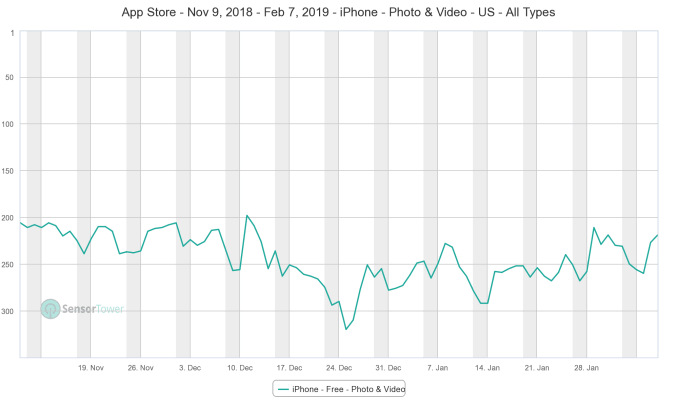 Instagram’s new video initiative also represents another shot across the bow of Instagram purists.
Instagram’s new video initiative also represents another shot across the bow of Instagram purists.
As BuzzFeed reporter Katie Notopoulos opined last year, “I’m Sorry To Report Instagram Is Bad Now.” Her point of concern was the impact that Stories had on the Instagram Feed — people were sharing to Stories instead of the Feed, which made the Feed pretty boring. At yet, the Stories content wasn’t good either, having become a firehose of the throwaway posts that didn’t deserve being shared directly on users’ profiles.
On top of all this, it seems the Instagram Feed is now going to be cluttered with IGTV previews. That’s. Just. Great.
Instagram says you’ll see the one-minute previews in the Feed, and can tap on them to turn on the audio. Tap the IGTV icon on the preview and you’ll be able to watch the full version in IGTV. When the video is finished, you’re returned to the Feed. Or, if you want to see more from IGTV, you can swipe up while the video plays to start browsing.
IGTV previews is only one way Instagram has been developing the product to attract more views in recent months. It has also integrated IGTV in Explore, allowed the sharing of IGTV videos to Stories, added the ability to save IGTV Videos and launched IGTV Web Embeds.
Powered by WPeMatico
Netflix today is launching a new feature on iOS devices that will help make it easier to watch its shows when you’re offline. The “smart downloads” feature, as it’s called, will automatically delete a downloaded episode after you’ve finished watching, then download the next one — but only when you’re connected to Wi-Fi.
The idea is that users will no longer have to go through the tedious work of managing their downloads — deleting those they’ve watched or downloading new titles, for example. Instead, the app can manage the downloads for you, so people can spend more time watching Netflix shows.
Smart downloads make sense for those who plan for intermittent connectivity — like commuters who take underground trains, for instance, or those who travel through dead spots where wireless coverage drops. It also makes sense for those on limited data plans, who are careful about not using streaming video apps unless they’re on Wi-Fi.
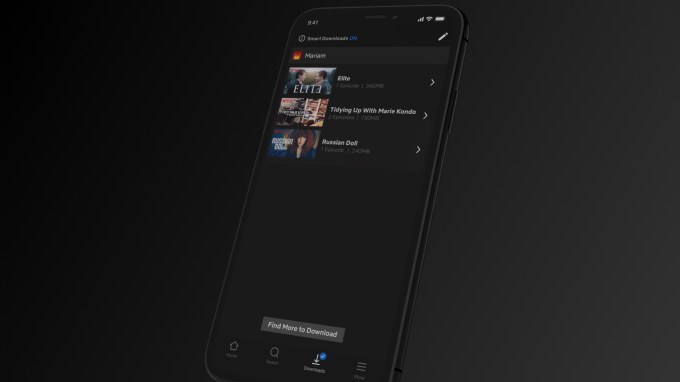
Offline features like this are key to attracting and retaining users in emerging markets where connectivity concerns are the norm. That’s likely why Netflix prioritized Android over iOS, for the initial launch of smart downloads.
The feature had first arrived on Android last summer. It’s now offered across platforms, including iOS and in the Windows 10 Netflix app, the company says.
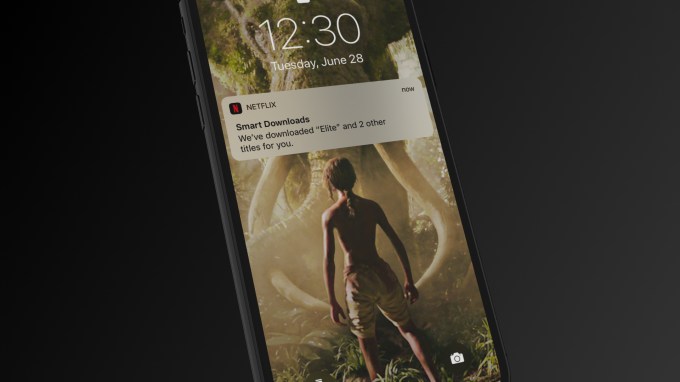
Offline access is only one area where Netflix is focusing on the needs of those in developing markets. The company late last year also began testing a more affordable, mobile-only subscription.
Non-U.S. users accounted for 7.31 million of the 8.8 million new subscribers Netflix added in the last quarter, as the U.S. market has become more saturated.
To use smart downloads on iOS, you can toggle the option in the Netflix app settings. It then turns itself on when you’re connected to Wi-Fi, to ensure your data plan won’t be used and your device storage won’t fill up as you watch offline. The feature will alert you when the episode in question has been downloaded.
“The faster our members can get to the next episode of their favorite stories, the better. Now, fans on the Netflix iOS app can get in on the fun and convenience of Smart Downloads, spending less time managing their downloads and more time watching,” said a Netflix spokesperson in a statement about the launch. “The feature is one more way we’re making it easier for Netflix fans to take the stories they love wherever they go,” they added.
Powered by WPeMatico
That nasty FaceTime bug is now a thing of the past. You can now download and update your iPhone and iPad to re-enable Group FaceTime again. iOS 12.1.4 is a bug fix release and doesn’t contain any new feature other than this one.
Shortly after people found out that you could eavesdrop on somebody’s microphone or camera by starting a fake Group FaceTime call, Apple disabled Group FaceTime altogether. If you’re running iOS 12.1.3 or earlier, you simply can’t start or join a FaceTime call with more than two people.
The company has been working on a fix to re-enable Group FaceTime without the nasty bug. And that update is now available.
“We have fixed the Group FaceTime security bug on Apple’s servers and we will issue a software update to re-enable the feature for users next week,” Apple said in a statement last week. “We sincerely apologize to our customers who were affected and all who were concerned about this security issue. We appreciate everyone’s patience as we complete this process.”
Back up your iPhone or iPad to iCloud or your computer first using iTunes. You can then head over to the Settings app. Tap on “General” then “Software Update” to download and install the patch. The update is still propagating on Apple’s servers so it could take a few minutes before you see it.
Powered by WPeMatico
It was the Lehman Brothers of blockchain. 850,000 Bitcoin disappeared when cryptocurrency exchange Mt. Gox imploded in 2014 after a series of hacks. The incident cemented the industry’s reputation as frighteningly insecure. Now a controversial crypto celebrity named Brock Pierce is trying to get the Mt. Gox flameout’s 24,000 victims their money back and build a new company from the ashes.
Pierce spoke to TechCrunch for the first interview about Gox Rising — his plan to reboot the Mt. Gox brand and challenge Coinbase and Binance for the title of top cryptocurrency exchange. He claims there’s around $630 million and 150,000 Bitcoin waiting in the Mt. Gox bankruptcy trust, and Pierce wants to solve the legal and technical barriers to getting those assets distributed back to their rightful owners.
The consensus from several blockchain startup CEOs I spoke with was that the plot is “crazy”, but that it also has the potential to right one of the biggest wrongs marring the history of Bitcoin.

But the story starts with Magic: The Gathering. Mt. Gox launched in 2006 as a place for players of the fantasy card game to trade monsters and spells before cryptocurrency came of age. The Magic: The Gathering Online eXchange wasn’t designed to safeguard huge quantities of Bitcoin from legions of hackers, but founder Jed McCaleb pivoted the site in 2010. Seeking to focus on other projects, he gave 88 percent of the company to French software engineer Mark Karpeles, and kept 12 percent. By 2013, the Tokyo-based Mt. Gox had become the world’s leading cryptocurrency exchange, handling 70 percent of all Bitcoin trades. But security breaches, technology problems, and regulations were already plaguing the service.
Then everything fell apart. In February 2014, Mt. Gox halted withdrawls due to what it called a bug in Bitcoin, trapping assets in user accounts. Mt. Gox discovered that it had lost over 700,000 Bitcoins due to theft over the past few years. By the end of the month, it had suspended all trading and filed for bankruptcy protection, which would contribute to a 36 percent decline in Bitcoin’s price. It admitted that 100,000 of its own Bitcoin atop 750,000 owned by customers had been stolen.
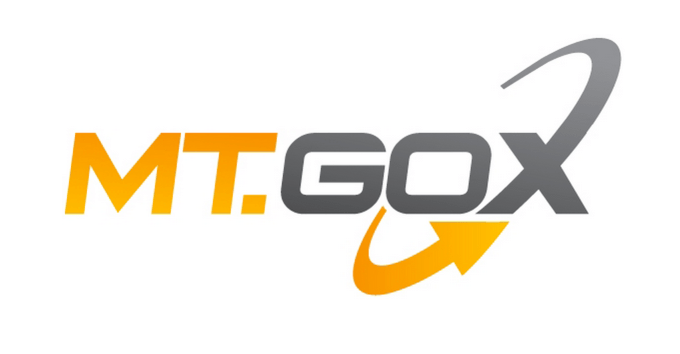
Mt. Gox is now undergoing bankruptcy rehabilitation in Japan overseen by court-appointed trustee and veteran bankruptcy lawyer Nobuaki Kobayashi to establish a process for compensating the 24,000 victims who filed claims. There’s now 137,892 Bitcoin, 162,106 Bitcoin Cash, and some other forked coins in Mt. Gox’s holdings, along with $630 million from the sale of 25 percent of the Bitcoin Kobayashi handled at a precient price point above where it is today. But five years later, creditors still haven’t been paid back.

Brock Pierce, the eccentric crypto celebrity
Pierce had actually tried to acquire Mt. Gox in 2013. The child actor known from The Mighty Ducks had gone on to work with a talent management company called Digital Entertainment Network. But accusations of sex crime led Pierce and some team members to flee the US to Spain until they were extradited back. Pierce wasn’t charged and paid roughly $21,000 to settle civil suits, but his cohorts were convicted of child molestation and child pornography.
The situation still haunts Pierce’s reputation and makes some in the industry apprehensive to be associated with him. But he managed to break into the virtual currency business, setting up World Of Warcraft gold mining farms in China. He claims to have eventually run the world’s largest exchanges for WOW Gold and Second Life Linden Dollars.
Soon Pierce was becoming a central figure in the blockchain scene. He co-founded Blockchain Capital, and eventually the EOS Alliance as well as a “crypto utopia” in Puerto Rico called Sol. His eccentric, Burning Man-influenced fashion made him easy to spot at the industry’s many conferences.
As Bitcoin and Mt. Gox rose in late 2012, Pierce tried to buy it, but “my biggest investor was Goldman Sachs. Goldman was not a fan of me buying the biggest Bitcoin exchange” due to the regulatory issues, Pierce tells me. But he also suspected the exchange was built on a shaky technical foundation that led him to stop pursuing the deal. “I thought there was a big risk factor in the Mt. Gox back-end. That was may intuition and I’m glad I was because my intuition was dead right.”
After Mt. Gox imploded, Pierce claims his investment group Sunlot Holdings successfully bought founder McCaleb’s 12 percent stake for 1 Bitcoin, though McCaleb says he didn’t receive the Bitcoin and it’s not clear if the deal went through. Pierce also claims he had a binding deal with Karpeles to buy the other 88 percent of Mt. Gox, but that Karpeles tried to pull out of the deal that remains in legal limbo.
The Sunlot has since been trying to handle the bankruptcy proceedings, but that arrangement was derailed by a lawsuit from CoinLab. That company had partnered with Mt. Gox to run its North American operations but claimed it never received the necessary assets, and sued Mt. Gox for $75 million, though Mt. Gox countersued saying CoinLab wasn’t legally certified to run the exchange in the US and that it hadn’t returned $5.3 million in customer deposits. For a detailed account the tangle of lawsuits, check out Reuters’ deep-dive into the Mt. Gox fiasco.

CoinLab co-founder Peter Vessenes
This week, CoinLab co-founder Peter Vessenes increased the claim and is now seeking $16 billion. Pierce alleges “this is a frivolous lawsuit. He’s claiming if [the partnership with Mt. Gox] hadn’t been cancelled, CoinLab would have been Coinbase and is suing for all the value. He believes Coinbase is worth $16 billion so he should be paid $16 billion. He embezzled money from Mt. Gox, he committed a crime, and he’s trying to extort the creditors. He’s holding up the entire process hoping he’ll get a payday.” Later, Pierce reiterated that “Coinlab is the villain trying to take all the money and see creditors get nothing.” Industry sources I spoke to agreed with that characterization
Mt. Gox customers worried that they might only receive the cash equivalent of their Bitcoin according to the currency’s $486 value when Gox closed in 2014. That’s despite the rise in Bitcoin’s value rising to around 7X that today, and as high as 40X at the currency’s peak. Luckily, in June 2018 a Japanese District Court halted bankruptcy proceedings and sent Mt. Gox into civil rehabilitation which means the company’s assets would be distributed to its creditors (the users) instead of liquidated. It also declared that users would be paid back their lost Bitcoin rather than the old cash value.
Now Pierce and Sunlot are attempting another rescue of Mt. Gox’s $1.2 billion assets. He wants to track down the remaining cryptocurrency that’s missing, have it all fairly valued, and then distribute the maximum amount to the robbed users with Mt. Gox equity shareholders including himself receiving nothing. That’s a much better deal for creditors than if Mt. Gox paid out the undervalued sum, and then shareholders like Pierce got to keep the Bitcoins or proceeds of their sale at today’s true value. “I‘ve been very blessed in my life I did commit to giving my first billion away” Pierce notes, joking that this plan could account for the first $700 million he plans to ‘donate’.
“Like Game Of Thrones, the last season of Mt. Gox hasn’t been written” Pierce tells me, speaking in terms HBO’s Silicon Valley would be quick to parody. “What kind of ending do we want to make for it? I’m a Joseph Campbell fan so I’m obviously going to go with a hero’s journey, with a rise and a fall, and then a rise from the ashes like a phoenix.”

But to make this happen, Sunlot needs at least half of those Mt. Gox users seeking compensation, or roughly 12,000 that represent the majority of assets, to sign up to join a creditors committee. That’s where GoxRising.com comes in. The plan is to have users join the committee there so they can present a united voice to Kobayashi about how they want Mt. Gox’s assets distributed. “I think that would allow the process to move faster than it would otherise. Things are on track to be resolved in the next three to five years. If [a majority of creditors sign on] this could be resolved in maybe 1 year.
Beyond providing whatever the Mt. Gox estate pays out, Pierce wants to create a Gox Coin that gives original Mt Gox creditors a stake in the new company. He plans to have all of Mt. Gox’s equity wiped out, including his own. Then he’ll arrange to finance and tokenize an independent foundation governed by the creditors that will seek to recover additional lost Mt. Gox assets and then distribute them pro rata to the Gox Coin holders. There are plenty of unanswered questions about the regulatory status of a Gox Coin and what holders would be entitled to, Pierce admits.
Meanwhile, Pierce is bidding to buy the intangibles of Mt. Gox, aka the brand and domain. He wants to then relaunch it as a Gox or Mt. Gox exchange that doesn’t provide custody itself for higher security.
“We want to offer [creditors] more than the bankruptcy trustee can do on its own” Pierce tells me. He concedes that the venture isn’t purely altruistic. “If the exchange is very successful I stand to benefit sometime down the road.” Still, he stands by his plan, even if the revived Mt. Gox never rises to legitimately challenge Binance, Coinbase, and other leading exchanges. Pierce concludes, “Whether we’re successful or not, I want to see the creditors made whole.” Those creditors will have to decide for themselves who to trust.
Powered by WPeMatico
Facebook’s crack down on non-consensual ad targeting last year will finally produce results. In March, TechCrunch discovered Facebook planned to require advertisers to pledge that they had permission to upload someone’s phone number or email address for ad targeting. That tool debuted in June, though there was no verification process and Facebook just took businesses at their word despite the financial incentive to lie. In November, Facebook launched a way for ad agencies and marketing tech developers to specify who they were buying promotions “on behalf of.” Soon that information will finally be revealed to users.
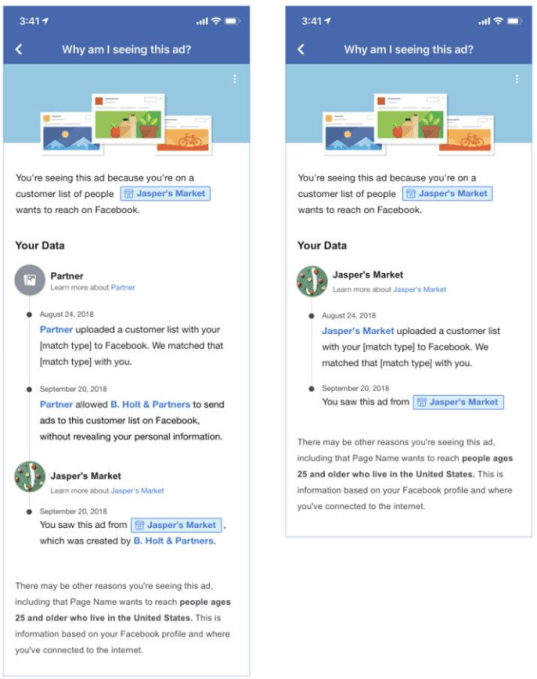
Facebook’s new Custom Audiences transparency feature shows when your contact info was uploaded and by whom, and if it was shared between brands and partners
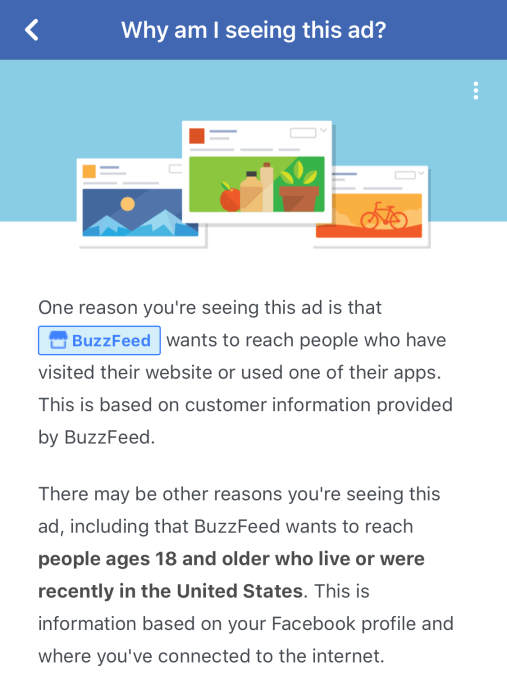
Facebook previously only revealed what brand was using your contact info for targeting, not who uploaded it or when
Starting February 28th, Facebook’s “Why am I seeing this?” button in the drop-down menu of feed posts will reveal more than the brand that paid for the ad, some biographical details they targeted and if they’d uploaded your contact info. Facebook will start to show when your contact info was uploaded, if it was by the brand or one of their agency/developer partners and when access was shared between partners. A Facebook spokesperson tells me the goal is to keep giving people a better understanding of how advertisers use their information.
This new level of transparency could help users pinpoint what caused a brand to get hold of their contact info. That might help them change their behavior to stay more private. The system could also help Facebook zero in on agencies or partners that are constantly uploading contact info and might not have attained it legitimately. Apparently seeking not to dredge up old privacy problems, Facebook didn’t publish a blog post about the change but simply announced it in a Facebook post to the Facebook Advertiser Hub Page.
The move comes in the wake of Facebook attaching immediately visible “paid for by” labels to more political ads to defend against election interference. With so many users concerned about how Facebook exploits their data, the Custom Audiences transparency feature could provide a small boost of confidence in a time when people have little faith in the social network’s privacy practices.
Powered by WPeMatico
Calm, the meditation and wellness app that launched back in 2012, has today announced the close of an $88 million Series B financing with a valuation of $1 billion. (We have not been able to clarify whether the valuation was post- or pre-money.)
The funding was led by TPG Growth, with participation from CAA and existing investors Insight Venture Partners and Sound Ventures.
As meditation grows in popularity across the U.S. — the CDC says it tripled from 4.1 percent in 2012 to 14.2 percent in 2017 — Calm has capitalized on the craze by offering a suite of mindfulness and wellness tools, from guided meditation sessions to a product called “Sleep Stories,” via a subscription.
But Calm is also meeting stress where it lives. For example, the company invested $3 million in XPresSpa late in 2018. XPresSpa is a chain of quick spa stores found in airports. Meanwhile, Calm partnered with American Airlines to offer Calm content within AA’s in-flight entertainment system.
The growth of Calm is hard to deny. The company says that it has topped 40 million downloads worldwide, with more than one million paying subscribers. Calm also says that it quadrupled its revenue in 2018 — the company is now profitable — and is on track to do $150 million in annual revenue.
With the new financing, Calm’s total amount raised comes to $116 million.
Moreover, Calm’s valuation has soared from $250 million at the beginning of 2018, on the heels of a $27 million Series A, to now hit $1 billion.
Here’s what co-founder and co-CEO Michael Acton Smith had to say in a prepared statement:
We started as a meditation app, but have grown far beyond that. Our vision is to build one of the most valuable and meaningful brands of the 21st century. Health and wellness is a $4 trillion industry and we believe there is a big opportunity to build the leading company in this fast growing and important space.
Co-founder and co-CEO Alex Tew said that the funding will predominantly go toward international growth and increased investment in content.
Powered by WPeMatico
French company Chauffeur-Privé is going to expand aggressively over the next couple of years. That’s why the company is changing its name to Kapten — a name that sounds less French.
“We wanted to share with you a very important piece of news,” Kapten co-founder and CEO Yan Hascoet said in a press conference. “We changed our name while keeping the same positioning.”
Kapten is one of the leading ridesharing players in France and recently launched in Lisbon (2 million users in France, 80,000 users in Lisbon). The company is going to launch in Geneva next week and London in the coming weeks. By 2020, Kapten should be in 15 major cities.
As a reminder, Daimler AG acquired a majority stake in Chauffeur-Privé/Kapten back in December 2017. Daimler AG and BMW Group later merged their mobility service businesses into a single entity called Intelligent Apps.
Kapten confirmed that Intelligent Apps will become Jurbey. Intelligent Apps’ free-floating services, parking services, charging services and itinerary apps will merge to simplify the product offering.
But Intelligent Apps’ ridesharing services (Chauffeur-Privé, mytaxi, Clever Taxi and Beat) won’t merge for now.
“It seems obvious that there will be some consolidation in five years in one way or another,” Hascoet said. “But this is not on today’s agenda.”
Hascoet thinks that the ridesharing space is still extremely competitive and there’s room for growth. It seems smarter to keep multiple services for now to see how it plays out in the coming years. Kapten is thinking about integrating Intelligent Apps’ scooter service Hive in its app, though.
Update: Kapten co-founder and CEO Yan Hascoet sent us the following statement:
- Daimler AG and BMW Group are merging their mobility service businesses into a single entity. After completion of the complex transaction on January 31, 2019, the new mobility services company, Daimler AG and the BMW Group, will present the next steps to be taken in the first quarter of 2019.
- The goal is to jointly create a major player for seamless and intelligently connected mobility services. The 50-50 joint venture will bring together the following five services: a multimodal mobility platform, car sharing, ride hailing, parking, and charging. Ride hailing will be based on mytaxi, Kapten (Chauffeur Privé), Clever Taxi and Beat.
- As a matter of principle, future brand names are neither confirmed nor commented on.
Kapten is also using today’s rebranding to launch an aggressive advertising campaign. The company will spend “millions of euros.”
There will be some tweaks to the service, as well. The minimum price is now €6 instead of €8 just like on Uber. Kapten will compensate that change by paying drivers the equivalent of an €8 ride for the time being. Eventually, Kapten wants drivers to generate as much revenue with €6 rides. In all cases, Kapten takes a 20 percent cut on each ride.
Drivers are also getting new features starting today. Free waiting time has been lowered from 5 minutes to 3 minutes, which should help drivers waste less time. There’s also a new feature to go back home and accept rides on the way.
The company also used this opportunity to share some numbers. Over the past 7 years, the company managed to attract 2 million clients and 200 companies who generated 20 million rides in total. In 2018 alone, Kapten handled 7.5 million rides with an average price of €17 to €18. It currently works with 22,000 drivers and 250 employees. Kapten will hire around 100 employees in 2019.
Kapten generated $54.9 million in revenue in 2016, $113 million in 2017 and $180.8 million in 2018 (€48.6 million, €100 million and €160 million respectively). Kapten wants to multiply its revenue by 5 by 2020.
In its announcement video, Kapten also differentiated its service from Uber by saying that they’ll keep paying taxes in local markets where they operate. The company wants to be the good guy; let’s see if that’s enough to capture some market share.
Powered by WPeMatico